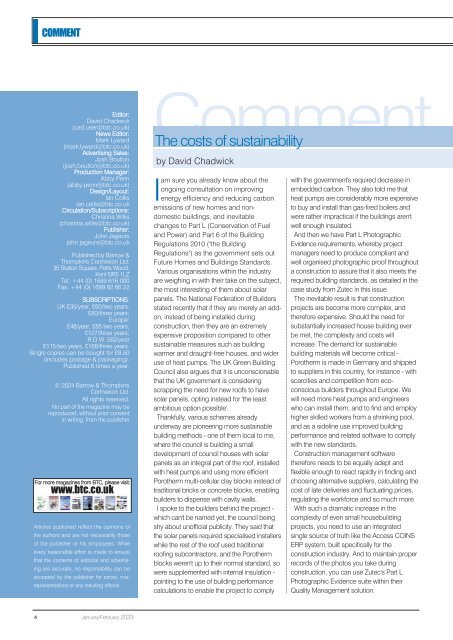CC4201
Create successful ePaper yourself
Turn your PDF publications into a flip-book with our unique Google optimized e-Paper software.
COMMENT<br />
Editor:<br />
David Chadwick<br />
(cad.user@btc.co.uk)<br />
News Editor:<br />
Mark Lyward<br />
(mark.lyward@btc.co.uk)<br />
Advertising Sales:<br />
Josh Boulton<br />
(josh.boulton@btc.co.uk)<br />
Production Manager:<br />
Abby Penn<br />
(abby.penn@btc.co.uk)<br />
Design/Layout:<br />
Ian Collis<br />
ian.collis@btc.co.uk<br />
Circulation/Subscriptions:<br />
Christina Willis<br />
(christina.willis@btc.co.uk)<br />
Publisher:<br />
John Jageurs<br />
john.jageurs@btc.co.uk<br />
Published by Barrow &<br />
Thompkins Connexion Ltd.<br />
35 Station Square, Petts Wood,<br />
Kent BR5 1LZ<br />
Tel: +44 (0) 1689 616 000<br />
Fax: +44 (0) 1689 82 66 22<br />
SUBSCRIPTIONS:<br />
UK £35/year, £60/two years,<br />
£80/three years;<br />
Europe:<br />
£48/year, £85 two years,<br />
£127/three years;<br />
R.O.W. £62/year<br />
£115/two years, £168/three years.<br />
Single copies can be bought for £8.50<br />
(includes postage & packaging).<br />
Published 6 times a year.<br />
© 2024 Barrow & Thompkins<br />
Connexion Ltd.<br />
All rights reserved.<br />
No part of the magazine may be<br />
reproduced, without prior consent<br />
in writing, from the publisher<br />
For more magazines from BTC, please visit:<br />
www.btc.co.uk<br />
Articles published reflect the opinions of<br />
the authors and are not necessarily those<br />
of the publisher or his employees. While<br />
every reasonable effort is made to ensure<br />
that the contents of editorial and advertising<br />
are accurate, no responsibility can be<br />
accepted by the publisher for errors, misrepresentations<br />
or any resulting effects<br />
Comment<br />
The costs of sustainability<br />
by David Chadwick<br />
Iam sure you already know about the<br />
ongoing consultation on improving<br />
energy efficiency and reducing carbon<br />
emissions of new homes and nondomestic<br />
buildings, and inevitable<br />
changes to Part L (Conservation of Fuel<br />
and Power) and Part 6 of the Building<br />
Regulations 2010 ("the Building<br />
Regulations") as the government sets out<br />
Future Homes and Buildings Standards.<br />
Various organisations within the industry<br />
are weighing in with their take on the subject,<br />
the most interesting of them about solar<br />
panels. The National Federation of Builders<br />
stated recently that if they are merely an addon,<br />
instead of being installed during<br />
construction, then they are an extremely<br />
expensive proposition compared to other<br />
sustainable measures such as building<br />
warmer and draught-free houses, and wider<br />
use of heat pumps. The UK Green Building<br />
Council also argues that it is unconscionable<br />
that the UK government is considering<br />
scrapping the need for new roofs to have<br />
solar panels, opting instead for 'the least<br />
ambitious option possible'.<br />
Thankfully, various schemes already<br />
underway are pioneering more sustainable<br />
building methods - one of them local to me,<br />
where the council is building a small<br />
development of council houses with solar<br />
panels as an integral part of the roof, installed<br />
with heat pumps and using more efficient<br />
Porotherm multi-cellular clay blocks instead of<br />
traditional bricks or concrete blocks, enabling<br />
builders to dispense with cavity walls.<br />
I spoke to the builders behind the project -<br />
which can't be named yet, the council being<br />
shy about unofficial publicity. They said that<br />
the solar panels required specialised installers<br />
while the rest of the roof used traditional<br />
roofing subcontractors, and the Porotherm<br />
blocks weren't up to their normal standard, so<br />
were supplemented with internal insulation -<br />
pointing to the use of building performance<br />
calculations to enable the project to comply<br />
with the government's required decrease in<br />
embedded carbon. They also told me that<br />
heat pumps are considerably more expensive<br />
to buy and install than gas-fired boilers and<br />
were rather impractical if the buildings aren't<br />
well enough insulated.<br />
And then we have Part L Photographic<br />
Evidence requirements, whereby project<br />
managers need to produce compliant and<br />
well organised photographic proof throughout<br />
a construction to assure that it also meets the<br />
required building standards, as detailed in the<br />
case study from Zutec in this issue.<br />
The inevitable result is that construction<br />
projects are become more complex, and<br />
therefore expensive. Should the need for<br />
substantially increased house building ever<br />
be met, the complexity and costs will<br />
increase. The demand for sustainable<br />
building materials will become critical -<br />
Porotherm is made in Germany and shipped<br />
to suppliers in this country, for instance - with<br />
scarcities and competition from ecoconscious<br />
builders throughout Europe. We<br />
will need more heat pumps and engineers<br />
who can install them, and to find and employ<br />
higher skilled workers from a shrinking pool,<br />
and as a sideline use improved building<br />
performance and related software to comply<br />
with the new standards.<br />
Construction management software<br />
therefore needs to be equally adept and<br />
flexible enough to react rapidly in finding and<br />
choosing alternative suppliers, calculating the<br />
cost of late deliveries and fluctuating prices,<br />
regulating the workforce and so much more.<br />
With such a dramatic increase in the<br />
complexity of even small housebuilding<br />
projects, you need to use an integrated<br />
single source of truth like the Access COINS<br />
ERP system, built specifically for the<br />
construction industry. And to maintain proper<br />
records of the photos you take during<br />
construction, you can use Zutec's Part L<br />
Photographic Evidence suite within their<br />
Quality Management solution.<br />
4 January/February 2023
















